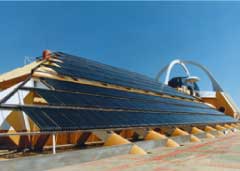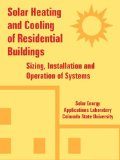
Cool! Solar cooled in Southern China
Some of us use the sun’s energy which helps to heating home. But many months of the year (or all year round, in some places), heating the house is the last thing we want. There are ways to keep the sun’s heat away from our home and keep down those expensive air conditioner bills.
What do you do on a hot summer vacation days when you want a moment’s respite? Find some shade, stoopid.
This is a smart idea for your house as well. Effective landscaping not only prevents sunlight from entering your home unimpeded, but the leafy foliage itself can lower temperatures in the surrounding area by giving off moisture. Scientific studies have found that summer daytime temperatures in tree-shaded neighborhoods were around 3 degrees Celsius cooler than neighborhoods lacking trees.
And the shade doesn’t just have to come from living things. Awnings can also helps in home protection for specific areas, preventing the sunlight from making your living room feel more like a greenhouse. Best of all, you can get a retractable awning so you can let the sun in when you need more light and warmth and shut it out when you’ve had enough. Prices at RetractableAwnings.co.uk start at around 400 for a gear-activated awning.
Another way of passively cooling your home is to imitate nature yet again go underground. Lowering the ground floor of your home allows the structure to get in sync with the temperature of the earth itself, which is cooler and much more constant than the air temperature.
It’s also useful to have a way for heat inside the house to escape and be carried away. Well-placed ventilation systems can allow trapped warmth to get out of the house and even be blown away by natural breezes. Devices called thermal chimney also provide an escape route for heat. The chimneys use convective currents to draw heat up and out of a house.
So far we’ve mentioned ways of avoiding the sun’s power by preventing light and heat from entering or staying in the house. But that energy can also be useful in cooling a house. Solar cooling involves trapping sun power during the hottest parts of the day and using it to power air conditioners and other cooling devices. Some systems take advantage of temperature differences between day and night. A solar collector traps heat energy during the day, but as it trickles out at night, the movement of energy drives a pump. The pump’s movement can then be used to generate electricity and power air conditioners. Another type of system involves a photovoltaic battery the battery directly captures solar power, then runs the air conditioner using this energy. One of these devices, called the SunStation has been called the “California Dream System” because of its potential to prevent serious energy crises in some of the most energy-hungry parts of the world.
 The Solar House: Passive Heating and Cooling – buy it from Amazon UK
The Solar House: Passive Heating and Cooling – buy it from Amazon UK
In total there are four categories of cooling that can work off the grid:
a. Natural
b. Evaporative
c. Direct expansion
d. Geo-Exchange
Natural Cooling a. Cross ventilation/cooling This method depends on the movement of air through the space to equalize the pressure. Wind which blows against a wall or barrier is deflected around and above the barrier creating a higher pressure on the windward side of the building. b. Stack ventilation/cooling This method depend on the difference in air densities to provide air movement in the teaching space. Two vents are needed for this method to work.
Evaporative cooling — is an alternative to air-conditioning with low energy costs because no compressor is needed, only a fan and a pump. This method is good for areas with high outside air ventilation requirements. Evaporative cooling can be either direct or indirect. Direct cooling involves the water being exposed to an air stream.
Direct Expansion, or “DX” — cooling uses the vapor compression refrigeration cycle in which a fluid called a refrigerant moves heat from one part of the cycle to another.
Geocooling: The earth around a building can serve as a heat and cooling source. These system are known by many names include geothermal, earth-coupled, ground-coupled, close-loop and water-coupled. They all use a fluid transported by a hydronic system through a Ground Source Heat Pump (GSHP) to either remove heat from the ground to the air in a space when heat is needed or to transfer the heat from a space to the ground when cooling is required using a refrigeration cycle.
 Solar Heating And Cooling of Residential Buildings: Sizing, Installation And Operation of Systems – buy it from Amazon US
Solar Heating And Cooling of Residential Buildings: Sizing, Installation And Operation of Systems – buy it from Amazon US